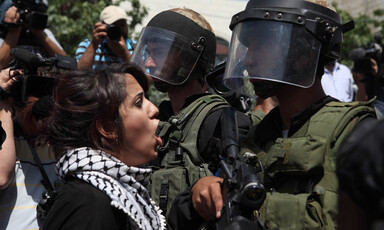
Theater company tackles social injustice in Gaza's streets
Beit Hanoun 27 October 2016
Bedouin discrimination the focus as Theatre Day Productions takes play to audiences. Read more about Theater company tackles social injustice in Gaza's streets

Beit Hanoun 27 October 2016
Bedouin discrimination the focus as Theatre Day Productions takes play to audiences. Read more about Theater company tackles social injustice in Gaza's streets

Beit Hanoun 10 February 2016
Bright paints provide contrast to colorless surroundings. Read more about Bringing color to Gaza's caravans

Beit Hanoun 12 July 2011
Every week a group of Palestinians risks death and injury by protesting at land confiscations near the Gaza-Israel boundary. Read more about Palestinians mark third year of Gaza "buffer zone" protests

Beit Hanoun 6 June 2011
While Lebanon’s Naksa Day demonstrations were prevented by Lebanese security, demonstrations went on throughout the occupied West Bank as well as by Palestine supporters worldwide. Read more about On Naksa Day, Palestinians carry on popular struggle

Beit Hanoun, Gaza Strip 29 January 2010
The Israeli military recently dropped hundreds of leaflets warning Palestinian residents from the village of Beit Hanoun in the northern Gaza Strip not to travel within 300 meters of the border — the distance of Israel’s so-called “buffer zone.” In response, local activists marched to and nonviolently demonstrated inside the “buffer zone” against the illegal action. The Electronic Intifada contributor Jody McIntyre recently spoke with demonstration organizer Saber Zanin. Read more about "Together we can end this occupation"

Beit Hanoun, Gaza Strip 16 November 2009
Ahmad’s first day of school was in 1991 during the first Palestinian intifada. Then six years old and living in the northern Gaza town of Beit Hanoun, Ahmad was a good student who enjoyed school. He worked hard and was always the first in his year. However, he was to have a different attitude towards education as frequent Israeli violence made completing his studies a struggle. Marryam Haleem writes from Beit Hanoun. Read more about Resisting through education

Beit Hanoun, Gaza Strip 18 September 2009
In Beit Hanoun, northern Gaza Strip, farmers sow the seeds of wholesome provision, for themselves and their families and their people, and the Israeli forces destroy it. So the farmers come back to plant. And the tanks and bulldozers come back to destroy it again. And the farmers come back to plant. Marryam Haleem writes for Live from Palestine. Read more about Abu Wael's farm

Beit Hanoun, Gaza Strip 5 September 2007
Sarah Abu Ghazal’s school uniform still lay on her mattress, untouched as she had left it before running out after her cousins Mahmoud and Yehya Abu Ghazal on Wednesday, 29 August. She was to begin the fourth grade on 2 September, but her friend Amani, who has accompanied her to school since the first grade, would walk alone this year. Sarah’s mother had bought her the blue school uniform, blue jeans and the black shoes just the day before she was killed by Israel tank fire. Her mother waited until the last minute to buy Sarah’s school supplies because she was waiting for her husband’s salary which he had not received since June. Read more about Sarah, Mahmoud and Yehya

Beit Hanoun, Palestine 26 November 2006
Between the 2nd and 8th of November 2006, the town of Beit Hanoun (population 28,000) was under a siege and blockade by Israeli Occupation Forces (IOF). Beit Hanoun is located in the Northern Gaza Strip, immediately south of the Apartheid Wall around Gaza and Erez Crossing with Israel. The besieged residents of Beit Hanoun suffered widespread collective punishment, such as a cut off of electricity and water. House to house searches were conducted, and males over the age of 16 years were summarily rounded up, imprisoned and interrogated. Many families were forced to huddle into rooms away from windows because Israeli snipers were on the rooftops killing people. Read more about Aftermath of the Beit Hanoun Siege and Massacre

Beit Hanoun, Gaza Strip 8 November 2006
One day after the Israel army declared that it had pulled out and completed Operation Autumn Clouds in the northern Gaza Strip town of Beit Hanoun, 24 Palestinians were killed in Gaza and the West Bank, 19 people were killed and at least 45 were injured as a large number of shells were fired at the town. Another five Palestinians were killed in Jenin, northern West Bank by Israeli army fire. The series of incidents began at 6 a.m., when eyewitness said that dozens of tank shells and missiles landed simultaneously in a small and limited area in Beit Hanoun. Ambulances found it difficult to evacuate the wounded. Read more about Massacre in Beit Hanoun